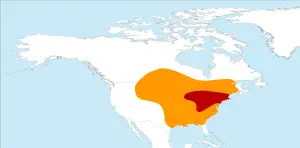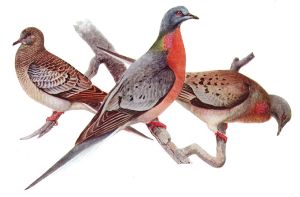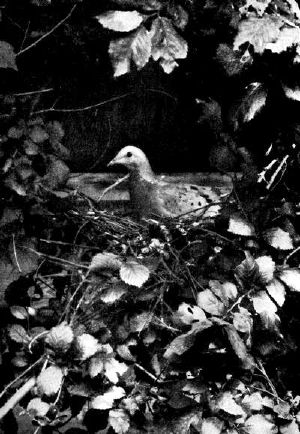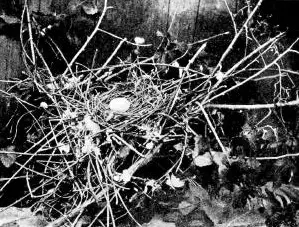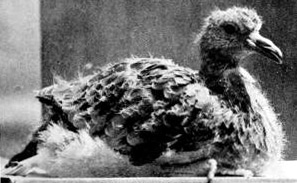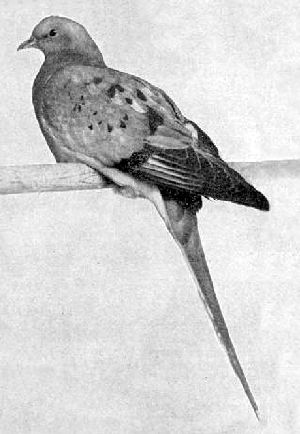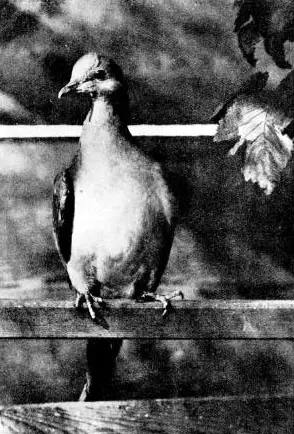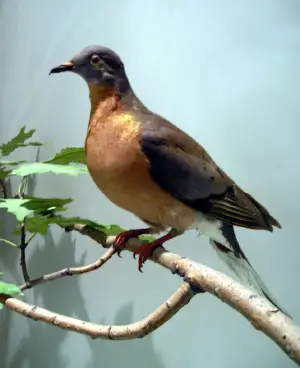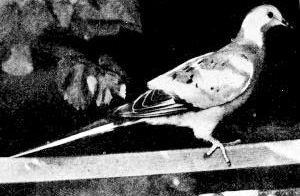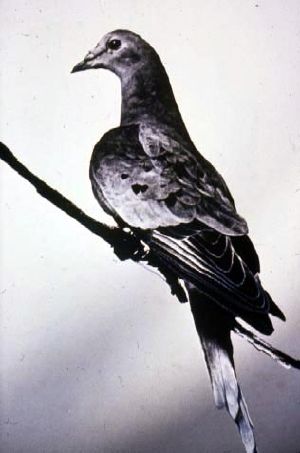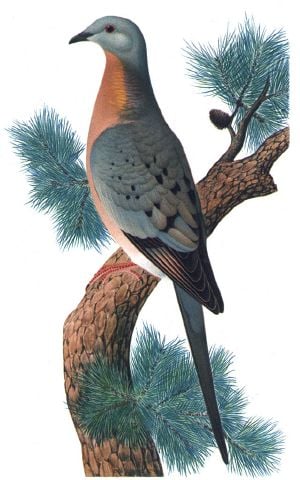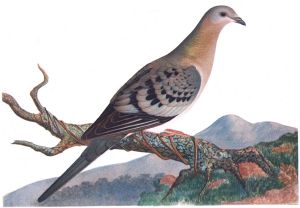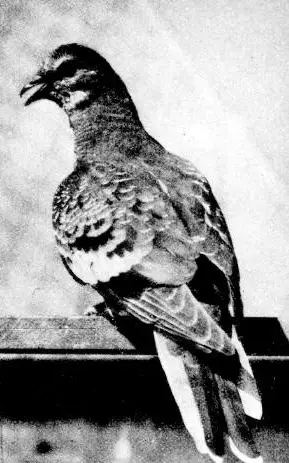Difference between revisions of "Passenger pigeon" - New World Encyclopedia
m (Robot: Remove claimed tag) |
Rick Swarts (talk | contribs) (added most recent version from Wikipedia) |
||
| Line 1: | Line 1: | ||
| − | |||
{{Taxobox | {{Taxobox | ||
| − | |||
| name = Passenger Pigeon | | name = Passenger Pigeon | ||
| status = EX | | status = EX | ||
| extinct = 1914 | | extinct = 1914 | ||
| status_system = iucn3.1 | | status_system = iucn3.1 | ||
| − | | image = | + | | image = Passengerpigeon.jpg |
| image_width = 200px | | image_width = 200px | ||
| − | | image_caption = | + | | image_caption = 1898 photograph of a live Passenger Pigeon |
| regnum = [[Animal]]ia | | regnum = [[Animal]]ia | ||
| phylum = [[Chordate|Chordata]] | | phylum = [[Chordate|Chordata]] | ||
| Line 20: | Line 18: | ||
| binomial_authority = ([[Carolus Linnaeus|Linnaeus]], 1766) | | binomial_authority = ([[Carolus Linnaeus|Linnaeus]], 1766) | ||
}} | }} | ||
| − | The '''Passenger Pigeon''' (''Ectopistes migratorius'') or ''' | + | The '''Passenger Pigeon''' (''Ectopistes migratorius'') or '''wild pigeon''' was a species of [[Columbidae|pigeon]] that was once the most common [[bird]] in [[North America]]. They lived in enormous flocks, and during migration, it was possible to see flocks of them a mile (1.6 km) wide and 300 miles (500 km) long, taking several days to pass and containing up to a billion birds.<ref>{{cite news |first= |last= |authorlink= |coauthors= |title=Three Hundred Dollars Reward; Will Be Paid for a Nesting Pair of Wild Pigeons, a Bird So Common in the United States Fifty Years Ago That Flocks in the Migratory Period Frequently Partially Obscured the Sun from View. How America Has Lost Birds of Rare Value and How Science Plans to Save Those That Are Left. |url= |quote=Unless the State and Federal Governments come to the rescue of American game, plumed and song birds, the not distant future will witness the practical extinction of some of the most beautiful and valuable species. Already the [[snowy heron]], that once swarmed in immense droves over the United States, is gone, a victim of the greed and cruelty of milliners whose "creations" its beautiful nuptial feathers have gone to adorn. |publisher=[[New York Times]] |date=[[January 16]] [[1910]] Sunday |accessdate=2007-07-21 }}</ref><ref>[http://www.findarticles.com/p/articles/mi_qa4128/is_200607/ai_n16537303 Ask]</ref> |
| − | |||
| − | |||
| − | |||
| − | |||
| − | They lived in enormous flocks, and during migration, | ||
| − | |||
| − | |||
| − | </ref><ref>[http://www.findarticles.com/p/articles/mi_qa4128/is_200607/ai_n16537303 Ask]</ref> | ||
| − | |||
| − | Some | + | Some estimate that there were as many as five billion passenger pigeons in the [[United States]] at the time [[Europe]]ans arrived in North America.<ref name=SI> |
| + | [http://www.si.edu/resource/faq/nmnh/passpig.htm Smithsonian Institution]; it is believed that this species once constituted 25 to 40 per cent of the total bird population of the United States. It is estimated that there were 3 billion to 5 billion passenger pigeons at the time Europeans discovered America.</ref> Others argue that the species had not been common in the [[Pre-Columbian]] period, but their numbers grew when devastation of the [[Indigenous peoples of the Americas|American Indian]] population by European diseases led to reduced competition for food.<ref > | ||
| + | "Prior to 1492, this was a rare species." | ||
| + | {{cite book | first= Charles C. |last= Mann |authorlink= Charles C. Mann | ||
| + | | title= [[1491: New Revelations of the Americas Before Columbus]] | ||
| + | | origdate= 2005-08-12 | publisher= [[Alfred A. Knopf]] | ||
| + | | location= [[New York City|New York]] |isbn= 1-4000-4006-X | ||
| + | | pages= pp. 315–8 |chapter= The Artificial Wilderness }} | ||
| + | </ref> | ||
| − | + | During the 19th century, the species went from being one of the most abundant birds in the world to extinction.<ref>{{IUCN2006|assessors=BirdLife International|year=2004|id=7031|title=Ectopistes migratorius|downloaded=10 May 2006}} Database entry includes justification for why this species is listed as extinct</ref> | |
| + | At the time, passenger pigeons had one of the largest groups or flocks of any animal, second only to the [[desert locust]]. They became such a threat to farmers that in 1703 the Roman Catholic bishop of Quebec actually formally excommunicated the species.<ref>Mann, Charles C. (2005): ''1491: New Revelations of the Americas before Columbus''. Vintage Books edition. 2006, p. 354. ISBN 978-1-4000-3205-1.</ref> | ||
| − | In [[Algonquian languages]], it was called ''amimi'' by the [[Lenape language|Lenape]] and ''omiimii'' by the [[Anishinaabe language|Ojibwe]]. | + | Some reduction in numbers occurred as a result of loss of habitat, when the Europeans started settling further inland. However, the primary factor emerged when pigeon meat was commercialized as a cheap food for [[slave]]s and the poor in the 19th century, resulting in hunting on a massive scale. There was a slow decline in their numbers between about 1800 and 1870, followed by a catastrophic decline between 1870 and 1890.<ref>http://www.sciencenetlinks.com/pdfs/pigeons1_actsheet.pdf</ref> "Martha", thought to be the world's last passenger pigeon, died on [[September 1]] [[1914]] in [[Cincinnati, Ohio]]. |
| + | |||
| + | In the 18th century, the passenger pigeon in Europe was known to the [[France|French]] as "tourtre" but in [[New France]], the North American bird was called "tourte". In modern French, the bird is known as the ''pigeon migrateur''. | ||
| + | |||
| + | In [[Algonquian languages]], it was called ''amimi'' by the [[Lenape language|Lenape]] and ''omiimii'' by the [[Anishinaabe language|Ojibwe]]. The term "passenger pigeon" in English derives from the French word "passager" meaning to pass by. | ||
==Description== | ==Description== | ||
| − | During summer, passenger pigeons lived in forest habitats throughout | + | [[Image:Map-Ectopistes-migratorius.png|thumb|left|Distribution map of ''Ectopistes migratorius''. In red : breeding zone; In yellow : wintering zone]] |
| + | During summer, passenger pigeons lived in forest habitats throughout North America east of the [[Rocky Mountains]]: from eastern and central [[Canada]] to the northeast United States. In the winters, they migrated to the southern U.S. and occasionally to [[Mexico]] and [[Cuba]]. | ||
| − | The passenger pigeon was a very social bird. It lived in colonies stretching over hundreds of square miles, with up to a hundred nests in a single tree. Pigeon migration, in flocks numbering billions, was a spectacle without parallel: | + | The passenger pigeon was a very social bird. It lived in colonies stretching over hundreds of square miles, practicing [[communal breeding]] with up to a hundred nests in a single tree. Pigeon migration, in flocks numbering billions, was a spectacle without parallel: |
| − | {{cquote|Early explorers and settlers frequently mentioned passenger pigeons in their writings. [[Samuel de Champlain]] in 1605 reported "countless numbers," [[Gabriel Sagard-Theodat]] wrote of "infinite multitudes," and [[Cotton Mather]] described a flight as being about a mile in width and taking several hours to pass overhead. Yet by the early 1900s no wild passenger pigeons could be found. | + | {{cquote|Early explorers and settlers frequently mentioned passenger pigeons in their writings. [[Samuel de Champlain]] in 1605 reported "countless numbers," [[Gabriel Sagard-Theodat]] wrote of "infinite multitudes," and [[Cotton Mather]] described a flight as being about a mile in width and taking several hours to pass overhead. Yet by the early 1900s no wild passenger pigeons could be found. — ''The [[Smithsonian]] Encyclopedia''<ref name=SI/>}} |
==Causes of extinction == | ==Causes of extinction == | ||
| − | + | {{Refimprove|section|date=May 2008}} | |
| + | [[Image:Ectopistes migratoriusAAP042CA.jpg|thumb|Passenger Pigeon, Ectopistes migratorius, juvenile (left), male (center), female (right).]] | ||
| + | The extinction of the passenger pigeon is the result of multiple causes. Previously, the primary cause was held to be the commercial exploitation of pigeon meat on a massive scale.<ref name=SI/> However current examination focuses on the pigeon's loss of habitat. | ||
| + | |||
| + | Even prior to colonization, native Americans occasionally used pigeons for meat. | ||
| + | In the early 1800s, commercial hunters began netting and shooting the birds to sell in the city markets as food, as live targets for [[trap shooting]] and even as agricultural [[fertilizer]]. | ||
| + | |||
| + | Once pigeon meat became popular, commercial hunting started on a prodigious scale. The bird painter [[John James Audubon]] described the preparations for slaughter at a known pigeon-roosting site: | ||
| + | {{cquote|Few pigeons were then to be seen, but a great number of persons, with horses and wagons, guns and ammunition, had already established encampments on the borders. Two farmers from the vicinity of Russelsville, distant more than a hundred miles, had driven upwards of three hundred hogs to be fattened on the pigeons which were to be slaughtered. Here and there, the people employed in plucking and salting what had already been procured, were seen sitting in the midst of large piles of these birds. The dung lay several inches deep, covering the whole extent of the roosting-place.<ref>http://www.ulala.org/P_Pigeon/Audubon_Pigeon.html "On The Passenger Pigeon", Birds of America, John James Audubon</ref>}} | ||
| + | [[Image:Birdonnest.jpg|thumb|Nesting passenger pigeon.]] | ||
| + | Pigeons were shipped by the [[boxcar]]-load to the Eastern cities. In [[New York City]], in 1805, a pair of pigeons sold for two cents. Slaves and servants in 18th and 19th century America often saw no other meat. By the 1850s, it was noticed that the numbers of birds seemed to be decreasing, but still the slaughter continued, accelerating to an even greater level as more railroads and telegraphs were developed after the [[American Civil War]]. Three million pigeons were shipped by a single market hunter in the year 1878. | ||
| + | [[Image:Nestandegg.jpg|thumb|left|Nest and egg of a passenger pigeon.]] | ||
| + | [[Image:Young passenger pigeon.jpg|thumb|left|Passenger pigeon chick.]] | ||
| + | Another significant reason for its extinction was [[deforestation]]. The birds traveled and reproduced in prodigious numbers, satiating predators before any substantial negative impact was made in the bird's population. As their numbers decreased along with their habitat, the birds could no longer rely on high population density for protection. Without this mechanism, many ecologists believe, the species could not survive. | ||
| − | + | Possibly, the birds may have suffered from [[Newcastle disease]], an infectious bird disease that was introduced to North America; though the disease was identified in 1926, it has been posited as one of the factors leading to the extinction of the passenger pigeon. | |
| − | + | Attempts to revive the species by breeding the surviving captive birds were not successful. The passenger pigeon was a colonial and gregarious bird practicing [[communal roosting]] and [[communal breeding]] and needed large numbers for optimum breeding conditions. It was impossible to reestablish the species with just a few captive birds, and the small captive flocks weakened and died. Since no accurate data were recorded, it is only possible to give estimates on the size and population of these nesting areas. Each site may have covered many thousands of acres and the birds were so congested in these areas that hundreds of nests could be counted in each tree. One large nesting in Wisconsin was reported as covering 850 square miles, and the number of birds nesting there was estimated to be around 136,000,000. Their technique of survival had been based on mass tactics. | |
| + | [[Image:Passenger pigeon young.jpg|thumb|Young passenger pigeon.]] | ||
| + | There was safety in large flocks which often numbered hundreds of thousands of birds. When a flock of this huge a size established itself in an area, the number of local animal predators (such as wolves, foxes, weasels, and hawks) was so small compared to the total number of birds that little damage would be inflicted on the flock as a whole. This colonial way of life and communal breeding became very dangerous when man became a predator on the flocks. When the passenger pigeons were massed together, especially at a huge nesting site, it was easy for man to slaughter them in such great numbers that there were not enough birds left to successfully reproduce the species.<ref> [http://www.si.edu/Encyclopedia_SI/nmnh/passpig.htm "The Passenger Pigeon", ''Encyclopedia Smithsonian'', Prepared by the Department of Vertebrate Zoology, National Museum of Natural History in cooperation with the Public Inquiry Mail Service, Smithsonian Institution]</ref> As the flocks dwindled in size with resulting breakdown of social facilitation, it was doomed to disappear.<ref>[http://extinct.petermaas.nl/ Passenger Pigeon, The Extinction Website]</ref> | ||
| − | + | The extinction of the passenger pigeon aroused public interest in the [[conservation movement]] and resulted in new laws and practices which have prevented many other species from going extinct. | |
| − | |||
| − | |||
| − | |||
| − | |||
| − | |||
| − | |||
| − | |||
| − | |||
==Methods of killing== | ==Methods of killing== | ||
| − | Alcohol-soaked grain intoxicated the birds and made them easier to kill. Smoky fires were set to nesting trees to drive them from their nests. | + | [[Image:E. migratorius.jpg|thumb|left|Front view of a live passenger pigeon]] |
| − | <ref> | + | Alcohol-soaked grain intoxicated the birds and made them easier to kill. Smoky fires were set to nesting trees to drive them from their nests.<ref> |
[http://www.iowadnr.com/education/wldresbs.html Iowa Department of Natural Resources]</ref> | [http://www.iowadnr.com/education/wldresbs.html Iowa Department of Natural Resources]</ref> | ||
| − | + | One method of killing was to blind a single bird by sewing its eyes shut using a needle and thread. This bird's feet would be attached to a circular stool at the end of a stick that could be raised five or six feet in the air, then dropped back to the ground. As the bird attempted to land, it would flutter its wings, thus attracting the attention of other birds flying overhead. When the flock landed near this decoy bird, nets would trap the birds and the hunters would crush their heads between their thumb and forefinger. This has been claimed as the origin of the term [[informant|stool pigeon]],<ref>[http://www.time.com/time/magazine/article/0,9171,752706-2,00.html Stool Pigeon]</ref> though this etymology is disputed.<ref>[http://www.worldwidewords.org/qa/qa-sto2.htm World Wide Words: Stool pigeon<!-- Bot generated title —>]</ref> | |
| − | |||
| − | |||
| + | One of the last large nestings of passenger pigeons was at [[Petoskey, Michigan]], in 1878. Here 50,000 birds were killed each day and the hunt continued for nearly five months. When the adult birds that survived the slaughter attempted second nestings at new sites, they were located by the professional hunters and killed before they had a chance to raise any young. In 1896, the final flock of 250,000 were killed by [[United States|American]] [[sportsperson|sportsmen]] knowing that it was the last [[flock (birds)|flock]] of that size. | ||
| + | [[Image:ROM-BirdGallery-PassengerPigeon.png|thumb|Stuffed passenger pigeon, Bird Gallery, Royal Ontario Museum, Toronto.]] | ||
Conservationists were ineffective in stopping the slaughter. A bill was passed in the Michigan legislature making it illegal to net pigeons within two miles of a nesting area, but the law was weakly enforced. By the mid 1890s, the passenger pigeon had almost completely disappeared. It was too late to protect them by passing laws. In 1897, a bill was introduced in the Michigan legislature asking for a ten-year closed season on passenger pigeons. This was a futile gesture. | Conservationists were ineffective in stopping the slaughter. A bill was passed in the Michigan legislature making it illegal to net pigeons within two miles of a nesting area, but the law was weakly enforced. By the mid 1890s, the passenger pigeon had almost completely disappeared. It was too late to protect them by passing laws. In 1897, a bill was introduced in the Michigan legislature asking for a ten-year closed season on passenger pigeons. This was a futile gesture. | ||
A highly gregarious species, the flock could initiate courtship and reproduction only when they were gathered in large numbers; it was realized only too late that smaller groups of passenger pigeons could not breed successfully, and | A highly gregarious species, the flock could initiate courtship and reproduction only when they were gathered in large numbers; it was realized only too late that smaller groups of passenger pigeons could not breed successfully, and | ||
| − | the surviving numbers | + | the surviving numbers proved too few to re-establish the species.<ref name=SI/> Attempts at breeding among the captive population also failed for the same reasons. |
| − | proved too few to re-establish the species<ref name=SI/> | ||
==Last wild survivors== | ==Last wild survivors== | ||
| − | The last fully authenticated record of a wild bird was near Sargents, [[Pike County, Ohio]], on [[ | + | [[Image:Ectopistes migratorius.jpg|thumb|left|Live passenger pigeon]] |
| − | <!-- | + | The last fully authenticated record of a wild bird was near Sargents, [[Pike County, Ohio]], on [[22 March]], [[1900]],<ref name=SI/><ref>The date of March 24 was given in the report by Henniger, but there are many discrepancies with the actual circumstances, meaning he was writing from hearsay. A curator's note that apparently derives from an old specimen label has March 22.</ref> although many unconfirmed sightings were reported in the first decade of the 20th century.<ref>[http://www.ulala.org/P_Pigeon/Map_files/Alabama.html Passenger Pigeons in Alabama<!-- Bot generated title —>]</ref><ref>[http://lifeofbirds.com/2007/01/06/was-martha-the-last-pigeon-de-passage/ Life of birds – Was Martha the last “Pigean de passage”?<!-- Bot generated title —>]</ref><ref>[http://elibrary.unm.edu/sora/Auk/v077n04/p0399-p0420.pdf A History Of The Passenger Pigeon In Missouri<!-- Bot generated title —>]</ref> From 1909 to 1912, a reward was offered for a living specimen;<ref>[[New York Times]]; [[April 4]], [[1910]], Monday; Reward for Wild Pigeons. Ornithologists Offer $3,000 for the Discovery of Their Nests.</ref> - no specimens were found. However, unconfirmed sightings continued up to about 1930.<ref>[http://web.ncf.ca/bz050/HomePage.pigeon.html Passenger Pigeon<!-- Bot generated title —>]</ref> |
| − | |||
| − | |||
| − | |||
| − | |||
| − | —> | ||
| − | |||
| − | Reports of passenger pigeons | + | Reports of passenger pigeons sightings kept coming in from [[Arkansas]] and [[Louisiana]], in groups of tens and twenties, until the first decade of the 20th century. |
| − | The naturalist | + | The naturalist Charles Dury, of Cincinnati, Ohio, wrote in September 1910: |
{{cquote|One foggy day in October 1884, at 5 a.m. I looked out of my bedroom window, and as I looked six wild pigeons flew down and perched on the dead branches of a tall poplar tree that stood about one hundred feet away. As I gazed at them in delight, feeling as though old friends had come back, they quickly darted away and disappeared in the fog, the last I ever saw of any of these birds in this vicinity.<ref> | {{cquote|One foggy day in October 1884, at 5 a.m. I looked out of my bedroom window, and as I looked six wild pigeons flew down and perched on the dead branches of a tall poplar tree that stood about one hundred feet away. As I gazed at them in delight, feeling as though old friends had come back, they quickly darted away and disappeared in the fog, the last I ever saw of any of these birds in this vicinity.<ref> | ||
{{cite journal | {{cite journal | ||
| Line 97: | Line 100: | ||
|month = September | |month = September | ||
|year = 1910 | |year = 1910 | ||
| − | |pages = | + | |pages = 52–56 |
}}</ref>}} | }}</ref>}} | ||
==Martha== | ==Martha== | ||
| − | The | + | [[Image:Martha last passenger pigeon 1914.jpg|thumb|Martha, the last passenger pigeon.]] |
| + | In 1857, a bill was brought forth to the Ohio State Legislature seeking protection for the passenger pigeon. A Select Committee of the Senate filed a report stating "The passenger pigeon needs no protection. Wonderfully prolific, having the vast forests of the North as its breeding grounds, traveling hundreds of miles in search of food, it is here today and elsewhere tomorrow, and no ordinary destruction can lessen them, or be missed from the myriads that are yearly produced" <ref>Hornaday, W.T. 1913: ''Our Vanishing Wild Life. Its Extermination and Preservation''</ref> | ||
| + | |||
| + | Fifty-seven years later, on [[September 1]], [[1914]], Martha, the last known passenger pigeon, died in the [[Cincinnati Zoo]], [[Cincinnati, Ohio]]. Her body was frozen into a block of ice and sent to the [[Smithsonian Institution]], where it was skinned and mounted. Currently, Martha (named after [[Martha Washington]]) is in the museum's archived collection, and not on display.<ref>{{cite web|url=http://www.si.edu/Encyclopedia_SI/nmnh/passpig.htm|title=Encyclopedia Smithsonian|accessdate=2008-05-12}}</ref> | ||
==Popular culture== | ==Popular culture== | ||
| − | [[Image: | + | [[Image:Ectopistes migratoriusMCN2P28CA.jpg|thumb|right|[[Chromolithography|Chromolithograph]] illustration of male passenger pigeon.]] |
| + | [[Image:Ectopistes migratoriusFCN2P29CA.jpg|right|thumb|Female passenger pigeon]] | ||
| + | [[Image:Passenger pigeon.jpg|thumb|Passenger pigeon.]] | ||
| − | The dramatic story of the passenger pigeon has taken a strong hold on popular | + | The dramatic story of the passenger pigeon has taken a strong hold on popular imagination. |
*The musician [[John Herald]] wrote a song about Martha, "Martha (Last of the Passenger Pigeons)". | *The musician [[John Herald]] wrote a song about Martha, "Martha (Last of the Passenger Pigeons)". | ||
| − | + | *The [[April 27]], [[1948]] episode of the ''[[Fibber McGee and Molly]]'' radio program is titled "The Passenger Pigeon Trap", in which McGee claims to have seen a passenger pigeon (he insists that the bird is "[[extinct|stinct]]") and plans to trap it in order to sell it to the highest bidder. It turns out to be nothing more than a [[Rock Pigeon]] (''Columba livia'') sitting on top of a bus, which in McGee's mind makes the pigeon a passenger. Hence, ''"passenger pigeon".'' This episode has two inaccuracies regarding the last Passenger Pigeon. According to the character known as "Mr. Old Timer", the name of the last pigeon is incorrectly named Millie, not Martha, and died on July 4, 1914, not September 1, 1914. | |
| − | *The April 27, 1948 episode of the ''[[Fibber McGee and Molly]]'' radio program is titled "The Passenger Pigeon Trap", in which McGee claims to have seen a passenger pigeon (he insists that the bird is "[[extinct|stinct]]") and plans to trap it in order to sell it to the highest bidder. It turns out to be nothing more than a [[Rock Pigeon | ||
| − | |||
*In "[[The Man Trap (TOS episode)|The Man Trap]]", the premiere episode of ''[[Star Trek: The Original Series|Star Trek]]'', Professor Crater likens the near-extinction of the inhabitants of planet M113 to the demise of the passenger pigeon. | *In "[[The Man Trap (TOS episode)|The Man Trap]]", the premiere episode of ''[[Star Trek: The Original Series|Star Trek]]'', Professor Crater likens the near-extinction of the inhabitants of planet M113 to the demise of the passenger pigeon. | ||
| − | + | *A one-shot episode of ''[[The Bloodhound Gang (TV Series)|The Bloodhound Gang]]'', entitled "The Case of the Dead Man's Pigeon", had the deceased Mr. Fowler allegedly cutting off his living relative and leaving his fortune to a society dedicated to preserving the American Passenger Pigeon, according to a revised will of his. But Vicki learns and points out that the American Passenger Pigeon was officially extinct in 1914, thus making Mr. Fowler's revised final will a fake. It was actually forged by the shady lawyer who reads the will, Mr. Pettifog, as a swindle. | |
*[[Stephen King]] makes a number of references to the passenger pigeon in the 2005 novel ''[[Cell (novel)|Cell]]''. He uses the pigeon as an allegory to the new human hive mind that develops after the pulse hits the United States. | *[[Stephen King]] makes a number of references to the passenger pigeon in the 2005 novel ''[[Cell (novel)|Cell]]''. He uses the pigeon as an allegory to the new human hive mind that develops after the pulse hits the United States. | ||
| − | |||
*In the 1999 movie by [[Jim Jarmusch]], ''[[Ghost Dog|Ghost Dog: The Way of the Samurai]]'', Louie ([[John Tormey]]) identifies the bird owned by the titular character as a "[[carrier pigeon]]". He is corrected by an elderly [[mafioso]] who shouts, "Passenger pigeon! Passenger pigeon! They've been extinct since 1914!" (The bird was in fact one of the [[homing pigeon]]s Ghost Dog used to transport - "carry" - notes, which explains Louie's misidentification). | *In the 1999 movie by [[Jim Jarmusch]], ''[[Ghost Dog|Ghost Dog: The Way of the Samurai]]'', Louie ([[John Tormey]]) identifies the bird owned by the titular character as a "[[carrier pigeon]]". He is corrected by an elderly [[mafioso]] who shouts, "Passenger pigeon! Passenger pigeon! They've been extinct since 1914!" (The bird was in fact one of the [[homing pigeon]]s Ghost Dog used to transport - "carry" - notes, which explains Louie's misidentification). | ||
| − | + | *''Ectopistes migratorius'' is the second chapter of the novel ''Havana Glam'' (2001) by [[Wu Ming]] 5. The reappearance of the pigeons in 1944 is the first signal of the arrival of time travelers from the 21st century USA. | |
| − | |||
| − | |||
| − | *''Ectopistes migratorius'' is the second chapter of the novel ''Havana Glam'' (2001) by [[Wu Ming]] 5. The reappearance of the pigeons in 1944 is the first signal of the arrival of time travelers from the 21st century | ||
| − | |||
*A description of the passage of a flock of passenger pigeons, and the killing of large numbers of the birds, is given in [[James Fenimore Cooper]]'s novel ''[[The Pioneers]]''. Although this was published in 1823, [[Natty Bumppo]] expresses outrage at people's "wastey ways" and concern about the possible future extinction of the bird. | *A description of the passage of a flock of passenger pigeons, and the killing of large numbers of the birds, is given in [[James Fenimore Cooper]]'s novel ''[[The Pioneers]]''. Although this was published in 1823, [[Natty Bumppo]] expresses outrage at people's "wastey ways" and concern about the possible future extinction of the bird. | ||
| − | |||
*The Australian poet Judith Wright wrote a poem called "Lament For Passenger Pigeons." | *The Australian poet Judith Wright wrote a poem called "Lament For Passenger Pigeons." | ||
| − | + | *The Indie-Rock band [[Paint By Numbers]] wrote a song called "Martha, Sweet Martha" in memory of the last passenger pigeon. | |
| − | *The Indie-Rock band [[ | + | * The alt-country duo [[The Handsome Family]] have a song called "Passenger Pigeons" featuring on their 2001 album ''Twilight'' |
| + | *Large passenger pigeons flocks appear in two of [[Howard Waldrop|Howard Waldrop's]] works: [[Howard Who?|"...the World, as we Know't"]] and ''[[Them Bones]]''. | ||
==Place names== | ==Place names== | ||
| − | |||
Across North America, place names refer to the former abundance of the passenger pigeon. Examples include: | Across North America, place names refer to the former abundance of the passenger pigeon. Examples include: | ||
* Crockford Pigeon Mountain, [[Georgia (U.S. state)|Georgia]] | * Crockford Pigeon Mountain, [[Georgia (U.S. state)|Georgia]] | ||
* [[Mimico]], a neighborhood of Toronto, Ontario, Canada. The name means "The Place of the Passenger Pigeons" in the language of the [[Mississauga Indian]]s. | * [[Mimico]], a neighborhood of Toronto, Ontario, Canada. The name means "The Place of the Passenger Pigeons" in the language of the [[Mississauga Indian]]s. | ||
* [[Pigeon Forge, Tennessee]] | * [[Pigeon Forge, Tennessee]] | ||
| − | * Pigeon Lakes: [[Minnesota]], [[Wisconsin]] | + | * Pigeon Lakes: [[Minnesota]], [[Wisconsin]], [[Pigeon Lake (Alberta)|Alberta]], [[Ontario]] |
| + | * Pigeon Point: [[Minnesota]] | ||
* [[Pigeon River]]s in: [[Pigeon River (Minnesota-Ontario)|Minnesota-Ontario]], [[Pigeon River (Tennessee - North Carolina)|North Carolina/Tennessee]], [[Michigan]] (four), and [[Wisconsin]] | * [[Pigeon River]]s in: [[Pigeon River (Minnesota-Ontario)|Minnesota-Ontario]], [[Pigeon River (Tennessee - North Carolina)|North Carolina/Tennessee]], [[Michigan]] (four), and [[Wisconsin]] | ||
| − | * Pigeon Roost, [[Indiana]] | + | * [[Pigeon Roost State Historic Site]], [[Indiana]] |
* Pigeontown, Pennsylvania, now known as [[Blue Bell, Pennsylvania|Blue Bell]] | * Pigeontown, Pennsylvania, now known as [[Blue Bell, Pennsylvania|Blue Bell]] | ||
* [[White Pigeon, Michigan]]. | * [[White Pigeon, Michigan]]. | ||
| + | * [[Pigeon Hill, Marietta Georgia]]. | ||
| + | * Ile-Aux-Tourtes, an island west of Montreal Island on the Trans-Canada Highway-Autoroute 40. It means, Passenger Pigeon Island (in French-Canadian). | ||
| + | * Pigeon, Pennsylvania | ||
==Coextinction== | ==Coextinction== | ||
| − | + | An often-cited example of [[coextinction]] is that of the passenger pigeon and its [[parasite|parasitic]] [[louse|lice]] ''[[Columbicola extinctus]]'' and ''Campanulotes defectus''. Recently,<ref name="Clayton1999">Clayton, D. H., and R. D. Price. 1999. Taxonomy of New World Columbicola (Phthiraptera: Philopteridae) from the Columbiformes (Aves), with descriptions of five new species. Ann. Entomol. Soc. Am. 92:675–685.</ref><ref name="Price2000">Price, R.D., D. H. Clayton, R. J. Adams, J. (2000) Pigeon lice down under: Taxonomy of Australian Campanulotes (Phthiraptera: Philopteridae), with a description of C. durdeni n.sp. Parasitol. 86(5), p 948-950. American Society of Parasitologists. [http://darwin.biology.utah.edu/PubsHTML/ClaytonPDF/47.pdf Online pdf]</ref> ''C. extinctus'' was rediscovered on the [[Band-tailed Pigeon]], and ''C. defectus'' was found to be a likely case of misidentification of the existing ''[[Campanulotes flavus]]''. | |
| − | An often-cited example of [[coextinction]] is that of the passenger pigeon and its [[parasite|parasitic]] [[louse|lice]] ''[[Columbicola extinctus]]'' and ''Campanulotes defectus''. Recently<ref name="Clayton1999">Clayton, D. H., and R. D. Price. 1999. Taxonomy of New World Columbicola (Phthiraptera: Philopteridae) from the Columbiformes (Aves), with descriptions of five new species. Ann. Entomol. Soc. Am. 92:675–685.</ref><ref name="Price2000">Price, R.D., D. H. Clayton, R. J. Adams, J. (2000) Pigeon lice down under: Taxonomy of Australian Campanulotes (Phthiraptera: Philopteridae), with a description of C. durdeni n.sp. Parasitol. 86(5), p 948-950. American Society of Parasitologists. [http://darwin.biology.utah.edu/PubsHTML/ClaytonPDF/47.pdf Online pdf]</ref> | ||
==See also== | ==See also== | ||
| Line 149: | Line 152: | ||
*[[List of extinct animals]] | *[[List of extinct animals]] | ||
| − | ==References== | + | ==References==<!-- WilsonBull18:47,22:47 —> |
| − | < | + | {{reflist|2}} |
| − | == | + | ==Further reading== |
<!-- American Scholar73:57; AmAntiqu68:552; Condor39:12; Condor84:242; Condor108:721; Parmalee 1968: "Cave and Archaeological Deposits..." (PP bones at Modoc Rock Shelter, Illinois); ZoolJLinnSoc128:149 —> | <!-- American Scholar73:57; AmAntiqu68:552; Condor39:12; Condor84:242; Condor108:721; Parmalee 1968: "Cave and Archaeological Deposits..." (PP bones at Modoc Rock Shelter, Illinois); ZoolJLinnSoc128:149 —> | ||
* Weidensaul, Scott (1994). ''Mountains of the Heart: A Natural History of the Appalachians''. Golden, Colorado: Fulcrum Publishing. ISBN 1-55591-143-9. | * Weidensaul, Scott (1994). ''Mountains of the Heart: A Natural History of the Appalachians''. Golden, Colorado: Fulcrum Publishing. ISBN 1-55591-143-9. | ||
*Eckert, Allan W. (1965). ''The Silent Sky: The Incredible Extinction of the Passenger Pigeon''. Lincoln NE: IUniverse.com. ISBN 0-595-08963-1. | *Eckert, Allan W. (1965). ''The Silent Sky: The Incredible Extinction of the Passenger Pigeon''. Lincoln NE: IUniverse.com. ISBN 0-595-08963-1. | ||
| − | *[[New York Times]]; August 18, 1901, Wednesday; The Hon. Charles T. Dunning of Goshen, ex-Chief Clerk of the New York State Senate, has a fine collection of mounted specimens of birds, and among them is one of a bird that is today extinct, so far as any one has been able to discover, although less than fifteen years ago it was abundant on this continent and to the people of this State was as familiar as sparrows now are. | + | *[[New York Times]]; [[August 18]], [[1901]], Wednesday; The Hon. Charles T. Dunning of Goshen, ex-Chief Clerk of the New York State Senate, has a fine collection of mounted specimens of birds, and among them is one of a bird that is today extinct, so far as any one has been able to discover, although less than fifteen years ago it was abundant on this continent and to the people of this State was as familiar as sparrows now are. |
* Schorger, A.W. 1955. The Passenger Pigeon: Its Natural History and Extinction. University of Wisconsin Press, Madison, WI. Reprinted in paperback, 2004, by Blackburn Press. ISBN 1-930665-96-2. 424 pp. | * Schorger, A.W. 1955. The Passenger Pigeon: Its Natural History and Extinction. University of Wisconsin Press, Madison, WI. Reprinted in paperback, 2004, by Blackburn Press. ISBN 1-930665-96-2. 424 pp. | ||
| Line 162: | Line 165: | ||
{{Commons|Ectopistes migratorius}} | {{Commons|Ectopistes migratorius}} | ||
* [http://www.songbird.org/birds/extinct/passpigeon.htm Songbird Foundation: Passenger Pigeon] | * [http://www.songbird.org/birds/extinct/passpigeon.htm Songbird Foundation: Passenger Pigeon] | ||
| − | * [http:// | + | * [http://www.petermaas.nl/extinct/speciesinfo/passengerpigeon.htm The Extinction Website - Passenger Pigeon] |
* [http://www.passengerpigeon.org/ Passenger Pigeon Society] | * [http://www.passengerpigeon.org/ Passenger Pigeon Society] | ||
| + | * [http://www.npr.org/templates/story/story.php?storyId=14722376 The Demise of the Passenger Pigeon (as broadcast on NPR's Day to Day)] | ||
| + | * [http://nlbif.eti.uva.nl/naturalis/detail?lang=uk&id=39 3D view] of specimens RMNH 110.048, RMNH 15707, RMNH 110.090, RMNH 110.091, RMNH 110.092, RMNH 110.093, RMNH 110.089, RMNH 110.085, RMNH 110.086, RMNH 110.087 and RMNH 110.088 at [[Naturalis]], Leiden (requires [[QuickTime]] browser plugin). | ||
| + | [[Category:Life sciences]] | ||
| + | [[Category:Animals]] | ||
| + | [[Category:Birds]] | ||
| − | {{credit| | + | {{credit|Passenger_Pigeon|247751190}} |
Revision as of 22:21, 27 October 2008
| Passenger Pigeon | ||||||||||||||
|---|---|---|---|---|---|---|---|---|---|---|---|---|---|---|
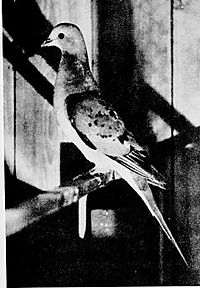 1898 photograph of a live Passenger Pigeon
| ||||||||||||||
| Scientific classification | ||||||||||||||
| ||||||||||||||
| Ectopistes migratorius (Linnaeus, 1766) |
The Passenger Pigeon (Ectopistes migratorius) or wild pigeon was a species of pigeon that was once the most common bird in North America. They lived in enormous flocks, and during migration, it was possible to see flocks of them a mile (1.6 km) wide and 300 miles (500 km) long, taking several days to pass and containing up to a billion birds.[1][2]
Some estimate that there were as many as five billion passenger pigeons in the United States at the time Europeans arrived in North America.[3] Others argue that the species had not been common in the Pre-Columbian period, but their numbers grew when devastation of the American Indian population by European diseases led to reduced competition for food.[4]
During the 19th century, the species went from being one of the most abundant birds in the world to extinction.[5] At the time, passenger pigeons had one of the largest groups or flocks of any animal, second only to the desert locust. They became such a threat to farmers that in 1703 the Roman Catholic bishop of Quebec actually formally excommunicated the species.[6]
Some reduction in numbers occurred as a result of loss of habitat, when the Europeans started settling further inland. However, the primary factor emerged when pigeon meat was commercialized as a cheap food for slaves and the poor in the 19th century, resulting in hunting on a massive scale. There was a slow decline in their numbers between about 1800 and 1870, followed by a catastrophic decline between 1870 and 1890.[7] "Martha", thought to be the world's last passenger pigeon, died on September 1 1914 in Cincinnati, Ohio.
In the 18th century, the passenger pigeon in Europe was known to the French as "tourtre" but in New France, the North American bird was called "tourte". In modern French, the bird is known as the pigeon migrateur.
In Algonquian languages, it was called amimi by the Lenape and omiimii by the Ojibwe. The term "passenger pigeon" in English derives from the French word "passager" meaning to pass by.
Description
During summer, passenger pigeons lived in forest habitats throughout North America east of the Rocky Mountains: from eastern and central Canada to the northeast United States. In the winters, they migrated to the southern U.S. and occasionally to Mexico and Cuba.
The passenger pigeon was a very social bird. It lived in colonies stretching over hundreds of square miles, practicing communal breeding with up to a hundred nests in a single tree. Pigeon migration, in flocks numbering billions, was a spectacle without parallel:
| “ | Early explorers and settlers frequently mentioned passenger pigeons in their writings. Samuel de Champlain in 1605 reported "countless numbers," Gabriel Sagard-Theodat wrote of "infinite multitudes," and Cotton Mather described a flight as being about a mile in width and taking several hours to pass overhead. Yet by the early 1900s no wild passenger pigeons could be found. — The Smithsonian Encyclopedia[3] | ” |
Causes of extinction
The extinction of the passenger pigeon is the result of multiple causes. Previously, the primary cause was held to be the commercial exploitation of pigeon meat on a massive scale.[3] However current examination focuses on the pigeon's loss of habitat.
Even prior to colonization, native Americans occasionally used pigeons for meat. In the early 1800s, commercial hunters began netting and shooting the birds to sell in the city markets as food, as live targets for trap shooting and even as agricultural fertilizer.
Once pigeon meat became popular, commercial hunting started on a prodigious scale. The bird painter John James Audubon described the preparations for slaughter at a known pigeon-roosting site:
| “ | Few pigeons were then to be seen, but a great number of persons, with horses and wagons, guns and ammunition, had already established encampments on the borders. Two farmers from the vicinity of Russelsville, distant more than a hundred miles, had driven upwards of three hundred hogs to be fattened on the pigeons which were to be slaughtered. Here and there, the people employed in plucking and salting what had already been procured, were seen sitting in the midst of large piles of these birds. The dung lay several inches deep, covering the whole extent of the roosting-place.[8] | ” |
Pigeons were shipped by the boxcar-load to the Eastern cities. In New York City, in 1805, a pair of pigeons sold for two cents. Slaves and servants in 18th and 19th century America often saw no other meat. By the 1850s, it was noticed that the numbers of birds seemed to be decreasing, but still the slaughter continued, accelerating to an even greater level as more railroads and telegraphs were developed after the American Civil War. Three million pigeons were shipped by a single market hunter in the year 1878.
Another significant reason for its extinction was deforestation. The birds traveled and reproduced in prodigious numbers, satiating predators before any substantial negative impact was made in the bird's population. As their numbers decreased along with their habitat, the birds could no longer rely on high population density for protection. Without this mechanism, many ecologists believe, the species could not survive.
Possibly, the birds may have suffered from Newcastle disease, an infectious bird disease that was introduced to North America; though the disease was identified in 1926, it has been posited as one of the factors leading to the extinction of the passenger pigeon.
Attempts to revive the species by breeding the surviving captive birds were not successful. The passenger pigeon was a colonial and gregarious bird practicing communal roosting and communal breeding and needed large numbers for optimum breeding conditions. It was impossible to reestablish the species with just a few captive birds, and the small captive flocks weakened and died. Since no accurate data were recorded, it is only possible to give estimates on the size and population of these nesting areas. Each site may have covered many thousands of acres and the birds were so congested in these areas that hundreds of nests could be counted in each tree. One large nesting in Wisconsin was reported as covering 850 square miles, and the number of birds nesting there was estimated to be around 136,000,000. Their technique of survival had been based on mass tactics.
There was safety in large flocks which often numbered hundreds of thousands of birds. When a flock of this huge a size established itself in an area, the number of local animal predators (such as wolves, foxes, weasels, and hawks) was so small compared to the total number of birds that little damage would be inflicted on the flock as a whole. This colonial way of life and communal breeding became very dangerous when man became a predator on the flocks. When the passenger pigeons were massed together, especially at a huge nesting site, it was easy for man to slaughter them in such great numbers that there were not enough birds left to successfully reproduce the species.[9] As the flocks dwindled in size with resulting breakdown of social facilitation, it was doomed to disappear.[10]
The extinction of the passenger pigeon aroused public interest in the conservation movement and resulted in new laws and practices which have prevented many other species from going extinct.
Methods of killing
Alcohol-soaked grain intoxicated the birds and made them easier to kill. Smoky fires were set to nesting trees to drive them from their nests.[11]
One method of killing was to blind a single bird by sewing its eyes shut using a needle and thread. This bird's feet would be attached to a circular stool at the end of a stick that could be raised five or six feet in the air, then dropped back to the ground. As the bird attempted to land, it would flutter its wings, thus attracting the attention of other birds flying overhead. When the flock landed near this decoy bird, nets would trap the birds and the hunters would crush their heads between their thumb and forefinger. This has been claimed as the origin of the term stool pigeon,[12] though this etymology is disputed.[13]
One of the last large nestings of passenger pigeons was at Petoskey, Michigan, in 1878. Here 50,000 birds were killed each day and the hunt continued for nearly five months. When the adult birds that survived the slaughter attempted second nestings at new sites, they were located by the professional hunters and killed before they had a chance to raise any young. In 1896, the final flock of 250,000 were killed by American sportsmen knowing that it was the last flock of that size.
Conservationists were ineffective in stopping the slaughter. A bill was passed in the Michigan legislature making it illegal to net pigeons within two miles of a nesting area, but the law was weakly enforced. By the mid 1890s, the passenger pigeon had almost completely disappeared. It was too late to protect them by passing laws. In 1897, a bill was introduced in the Michigan legislature asking for a ten-year closed season on passenger pigeons. This was a futile gesture. A highly gregarious species, the flock could initiate courtship and reproduction only when they were gathered in large numbers; it was realized only too late that smaller groups of passenger pigeons could not breed successfully, and the surviving numbers proved too few to re-establish the species.[3] Attempts at breeding among the captive population also failed for the same reasons.
Last wild survivors
The last fully authenticated record of a wild bird was near Sargents, Pike County, Ohio, on 22 March, 1900,[3][14] although many unconfirmed sightings were reported in the first decade of the 20th century.[15][16][17] From 1909 to 1912, a reward was offered for a living specimen;[18] - no specimens were found. However, unconfirmed sightings continued up to about 1930.[19]
Reports of passenger pigeons sightings kept coming in from Arkansas and Louisiana, in groups of tens and twenties, until the first decade of the 20th century.
The naturalist Charles Dury, of Cincinnati, Ohio, wrote in September 1910:
| “ | One foggy day in October 1884, at 5 a.m. I looked out of my bedroom window, and as I looked six wild pigeons flew down and perched on the dead branches of a tall poplar tree that stood about one hundred feet away. As I gazed at them in delight, feeling as though old friends had come back, they quickly darted away and disappeared in the fog, the last I ever saw of any of these birds in this vicinity.[20] | ” |
Martha
In 1857, a bill was brought forth to the Ohio State Legislature seeking protection for the passenger pigeon. A Select Committee of the Senate filed a report stating "The passenger pigeon needs no protection. Wonderfully prolific, having the vast forests of the North as its breeding grounds, traveling hundreds of miles in search of food, it is here today and elsewhere tomorrow, and no ordinary destruction can lessen them, or be missed from the myriads that are yearly produced" [21]
Fifty-seven years later, on September 1, 1914, Martha, the last known passenger pigeon, died in the Cincinnati Zoo, Cincinnati, Ohio. Her body was frozen into a block of ice and sent to the Smithsonian Institution, where it was skinned and mounted. Currently, Martha (named after Martha Washington) is in the museum's archived collection, and not on display.[22]
Popular culture
The dramatic story of the passenger pigeon has taken a strong hold on popular imagination.
- The musician John Herald wrote a song about Martha, "Martha (Last of the Passenger Pigeons)".
- The April 27, 1948 episode of the Fibber McGee and Molly radio program is titled "The Passenger Pigeon Trap", in which McGee claims to have seen a passenger pigeon (he insists that the bird is "stinct") and plans to trap it in order to sell it to the highest bidder. It turns out to be nothing more than a Rock Pigeon (Columba livia) sitting on top of a bus, which in McGee's mind makes the pigeon a passenger. Hence, "passenger pigeon". This episode has two inaccuracies regarding the last Passenger Pigeon. According to the character known as "Mr. Old Timer", the name of the last pigeon is incorrectly named Millie, not Martha, and died on July 4, 1914, not September 1, 1914.
- In "The Man Trap", the premiere episode of Star Trek, Professor Crater likens the near-extinction of the inhabitants of planet M113 to the demise of the passenger pigeon.
- A one-shot episode of The Bloodhound Gang, entitled "The Case of the Dead Man's Pigeon", had the deceased Mr. Fowler allegedly cutting off his living relative and leaving his fortune to a society dedicated to preserving the American Passenger Pigeon, according to a revised will of his. But Vicki learns and points out that the American Passenger Pigeon was officially extinct in 1914, thus making Mr. Fowler's revised final will a fake. It was actually forged by the shady lawyer who reads the will, Mr. Pettifog, as a swindle.
- Stephen King makes a number of references to the passenger pigeon in the 2005 novel Cell. He uses the pigeon as an allegory to the new human hive mind that develops after the pulse hits the United States.
- In the 1999 movie by Jim Jarmusch, Ghost Dog: The Way of the Samurai, Louie (John Tormey) identifies the bird owned by the titular character as a "carrier pigeon". He is corrected by an elderly mafioso who shouts, "Passenger pigeon! Passenger pigeon! They've been extinct since 1914!" (The bird was in fact one of the homing pigeons Ghost Dog used to transport - "carry" - notes, which explains Louie's misidentification).
- Ectopistes migratorius is the second chapter of the novel Havana Glam (2001) by Wu Ming 5. The reappearance of the pigeons in 1944 is the first signal of the arrival of time travelers from the 21st century USA.
- A description of the passage of a flock of passenger pigeons, and the killing of large numbers of the birds, is given in James Fenimore Cooper's novel The Pioneers. Although this was published in 1823, Natty Bumppo expresses outrage at people's "wastey ways" and concern about the possible future extinction of the bird.
- The Australian poet Judith Wright wrote a poem called "Lament For Passenger Pigeons."
- The Indie-Rock band Paint By Numbers wrote a song called "Martha, Sweet Martha" in memory of the last passenger pigeon.
- The alt-country duo The Handsome Family have a song called "Passenger Pigeons" featuring on their 2001 album Twilight
- Large passenger pigeons flocks appear in two of Howard Waldrop's works: "...the World, as we Know't" and Them Bones.
Place names
Across North America, place names refer to the former abundance of the passenger pigeon. Examples include:
- Crockford Pigeon Mountain, Georgia
- Mimico, a neighborhood of Toronto, Ontario, Canada. The name means "The Place of the Passenger Pigeons" in the language of the Mississauga Indians.
- Pigeon Forge, Tennessee
- Pigeon Lakes: Minnesota, Wisconsin, Alberta, Ontario
- Pigeon Point: Minnesota
- Pigeon Rivers in: Minnesota-Ontario, North Carolina/Tennessee, Michigan (four), and Wisconsin
- Pigeon Roost State Historic Site, Indiana
- Pigeontown, Pennsylvania, now known as Blue Bell
- White Pigeon, Michigan.
- Pigeon Hill, Marietta Georgia.
- Ile-Aux-Tourtes, an island west of Montreal Island on the Trans-Canada Highway-Autoroute 40. It means, Passenger Pigeon Island (in French-Canadian).
- Pigeon, Pennsylvania
Coextinction
An often-cited example of coextinction is that of the passenger pigeon and its parasitic lice Columbicola extinctus and Campanulotes defectus. Recently,[23][24] C. extinctus was rediscovered on the Band-tailed Pigeon, and C. defectus was found to be a likely case of misidentification of the existing Campanulotes flavus.
See also
- Extinct birds
- List of extinct animals
ReferencesISBN links support NWE through referral fees
- ↑ "Three Hundred Dollars Reward; Will Be Paid for a Nesting Pair of Wild Pigeons, a Bird So Common in the United States Fifty Years Ago That Flocks in the Migratory Period Frequently Partially Obscured the Sun from View. How America Has Lost Birds of Rare Value and How Science Plans to Save Those That Are Left.", New York Times, January 16 1910 Sunday. Retrieved 2007-07-21.
- ↑ Ask
- ↑ 3.0 3.1 3.2 3.3 3.4 Smithsonian Institution; it is believed that this species once constituted 25 to 40 per cent of the total bird population of the United States. It is estimated that there were 3 billion to 5 billion passenger pigeons at the time Europeans discovered America.
- ↑ "Prior to 1492, this was a rare species." Mann, Charles C. [2005-08-12]. "The Artificial Wilderness", 1491: New Revelations of the Americas Before Columbus. New York: Alfred A. Knopf, pp. 315–8. ISBN 1-4000-4006-X.
- ↑ BirdLife International 2004. [1]. 2006 IUCN Red List of Threatened Species., World Conservation Union. Retrieved on 10 May 2006. Database entry includes justification for why this species is listed as extinct
- ↑ Mann, Charles C. (2005): 1491: New Revelations of the Americas before Columbus. Vintage Books edition. 2006, p. 354. ISBN 978-1-4000-3205-1.
- ↑ http://www.sciencenetlinks.com/pdfs/pigeons1_actsheet.pdf
- ↑ http://www.ulala.org/P_Pigeon/Audubon_Pigeon.html "On The Passenger Pigeon", Birds of America, John James Audubon
- ↑ "The Passenger Pigeon", Encyclopedia Smithsonian, Prepared by the Department of Vertebrate Zoology, National Museum of Natural History in cooperation with the Public Inquiry Mail Service, Smithsonian Institution
- ↑ Passenger Pigeon, The Extinction Website
- ↑ Iowa Department of Natural Resources
- ↑ Stool Pigeon
- ↑ World Wide Words: Stool pigeon
- ↑ The date of March 24 was given in the report by Henniger, but there are many discrepancies with the actual circumstances, meaning he was writing from hearsay. A curator's note that apparently derives from an old specimen label has March 22.
- ↑ Passenger Pigeons in Alabama
- ↑ Life of birds – Was Martha the last “Pigean de passage”?
- ↑ A History Of The Passenger Pigeon In Missouri
- ↑ New York Times; April 4, 1910, Monday; Reward for Wild Pigeons. Ornithologists Offer $3,000 for the Discovery of Their Nests.
- ↑ Passenger Pigeon
- ↑ Dury, Charles (September 1910). The Passenger Pigeon. Journal of the Cincinnati Society of Natural History 21: 52–56.
- ↑ Hornaday, W.T. 1913: Our Vanishing Wild Life. Its Extermination and Preservation
- ↑ Encyclopedia Smithsonian. Retrieved 2008-05-12.
- ↑ Clayton, D. H., and R. D. Price. 1999. Taxonomy of New World Columbicola (Phthiraptera: Philopteridae) from the Columbiformes (Aves), with descriptions of five new species. Ann. Entomol. Soc. Am. 92:675–685.
- ↑ Price, R.D., D. H. Clayton, R. J. Adams, J. (2000) Pigeon lice down under: Taxonomy of Australian Campanulotes (Phthiraptera: Philopteridae), with a description of C. durdeni n.sp. Parasitol. 86(5), p 948-950. American Society of Parasitologists. Online pdf
Further reading
- Weidensaul, Scott (1994). Mountains of the Heart: A Natural History of the Appalachians. Golden, Colorado: Fulcrum Publishing. ISBN 1-55591-143-9.
- Eckert, Allan W. (1965). The Silent Sky: The Incredible Extinction of the Passenger Pigeon. Lincoln NE: IUniverse.com. ISBN 0-595-08963-1.
- New York Times; August 18, 1901, Wednesday; The Hon. Charles T. Dunning of Goshen, ex-Chief Clerk of the New York State Senate, has a fine collection of mounted specimens of birds, and among them is one of a bird that is today extinct, so far as any one has been able to discover, although less than fifteen years ago it was abundant on this continent and to the people of this State was as familiar as sparrows now are.
- Schorger, A.W. 1955. The Passenger Pigeon: Its Natural History and Extinction. University of Wisconsin Press, Madison, WI. Reprinted in paperback, 2004, by Blackburn Press. ISBN 1-930665-96-2. 424 pp.
External links
- Songbird Foundation: Passenger Pigeon
- The Extinction Website - Passenger Pigeon
- Passenger Pigeon Society
- The Demise of the Passenger Pigeon (as broadcast on NPR's Day to Day)
- 3D view of specimens RMNH 110.048, RMNH 15707, RMNH 110.090, RMNH 110.091, RMNH 110.092, RMNH 110.093, RMNH 110.089, RMNH 110.085, RMNH 110.086, RMNH 110.087 and RMNH 110.088 at Naturalis, Leiden (requires QuickTime browser plugin).
Credits
New World Encyclopedia writers and editors rewrote and completed the Wikipedia article in accordance with New World Encyclopedia standards. This article abides by terms of the Creative Commons CC-by-sa 3.0 License (CC-by-sa), which may be used and disseminated with proper attribution. Credit is due under the terms of this license that can reference both the New World Encyclopedia contributors and the selfless volunteer contributors of the Wikimedia Foundation. To cite this article click here for a list of acceptable citing formats.The history of earlier contributions by wikipedians is accessible to researchers here:
The history of this article since it was imported to New World Encyclopedia:
Note: Some restrictions may apply to use of individual images which are separately licensed.

